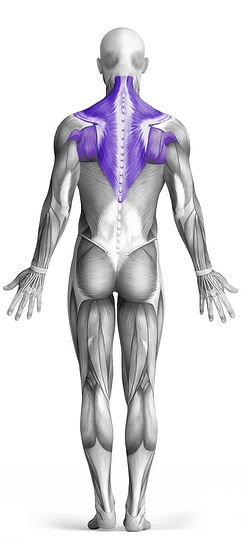Cable Rope Elevated Seated Row 101 Video Tutorial
0

Exercise Synopsis
Target Muscle Group
Upper Back
Secondary Targets
Execution
Compound
Force Type
Pull
Required Equipment
Cable Machine
Fitness Level
Intermediate
Variations
None
Alternatives
Timer
Hour
Minute
Second
Stopwatch
00:00:00:00
Overview
The Cable Rope Elevated Seated Row is an effective upper back exercise that primarily targets the upper back muscles, including the rhomboids and traps, while also engaging the lats as secondary muscles. Using a cable machine, the exercise involves sitting on a bench or platform with the rope attachment positioned higher than usual, pulling the rope towards your torso in a controlled motion. This movement helps to develop strength and definition in the upper back, improve posture, and enhance pulling strength. The elevated position of the rope adds a unique angle, further emphasizing the upper back muscles while minimizing strain on the lower back.
How to Perform
Begin by sitting on the cable machine seat, ensuring your feet are positioned securely on the elevated footrests for stability.
Take the rope handles with an overhand grip, and extend your arms fully in front of you, maintaining a neutral spine and a slight lean back to engage your core.
As you initiate the movement, pull the rope handles towards your torso by drawing your shoulder blades together and activating your upper back muscles.
At the peak of the motion, pause briefly, keeping your elbows close to your sides while ensuring your upper back is fully contracted.
Slowly return your arms to the starting position, feeling the stretch in your back muscles as you control the movement.
Repeat for the prescribed number of repetitions, focusing on maintaining good form throughout the exercise to maximize muscle engagement and reduce the risk of injury.
★ Bonus: For exercises that involve external weights (such as dumbbells, barbells, or machines), the One Rep Max (1RM) calculator can help you estimate your maximum lifting capacity. Use it to track your strength progress and adjust your training for optimal results.
Tips
Prioritize proper technique to effectively engage the muscles you aim to target and avoid unnecessary strain.
Gradually increase the resistance over time to keep challenging your muscles, which will support consistent strength development.
Keep your core activated throughout the movement, ensuring your torso remains stable and your posture stays aligned.
Control both the pulling (concentric) and returning (eccentric) movements to fully activate your muscles and maintain tension during the entire range of motion.
Keep your shoulders drawn back and down, away from your ears, to reduce the risk of stress on your neck and upper traps.
Use a complete range of motion by fully extending your arms and contracting your shoulder blades together during the peak of the pull.
Try different hand grips, such as overhand, underhand, or wide, to target various regions of your back and enhance muscle engagement.
Supplement this exercise with other movements like lat pulldowns and bent-over rows to ensure comprehensive back development.
Maintain a steady breathing rhythm, exhaling as you pull the rope toward your torso and inhaling as you return to the starting position.
Pay attention to your body’s signals, taking breaks when necessary to avoid overexertion and reduce the risk of injury.
How Not to Perform
Avoid Using Momentum: Do not swing your torso or use jerky movements to pull the rope. Focus on controlled, steady motion to ensure the muscle is doing the work and avoid wasting energy or causing unnecessary strain.
Do Not Overextend Your Arms: Keep your arms slightly bent during the starting position. Overextending them can put unnecessary stress on your shoulders and reduce the engagement of the upper back muscles.
Avoid Shrugging Your Shoulders: Do not allow your shoulders to rise toward your ears during the pull. Instead, keep your shoulders pulled back and down to avoid excessive strain on the traps and neck.
Do Not Arch Your Lower Back: Avoid hyperextending or rounding your lower back. Maintain a neutral spine throughout the movement to prevent back strain and ensure that the upper back muscles are doing the majority of the work.
Don’t Allow Elbows to Flare Out: Keep your elbows close to your body to maintain proper form and ensure the correct muscle groups (upper back and lats) are targeted. Flaring your elbows out can shift the focus away from these muscles and place stress on the shoulders.
Avoid Rapid, Shallow Movements: Ensure each repetition involves a full range of motion, both when pulling and returning the rope. Shallow movements can limit muscle activation and reduce the effectiveness of the exercise.
Do Not Rush the Exercise: Perform each rep slowly and with control. Rushing through the movement decreases muscle engagement and can increase the risk of injury.
Avoid Holding Your Breath: Breathe steadily throughout the exercise, exhaling during the pull and inhaling as you return to the starting position. Holding your breath can increase intra-abdominal pressure and lead to unnecessary tension.
Don’t Let Your Knees Lock: Keep a slight bend in your knees to ensure that you maintain stability and prevent straining the lower back.
Avoid Excessive Weight: Do not use a weight that’s too heavy to control. Using an appropriate weight allows you to maintain good form, focus on the target muscles, and minimize the risk of injury.
Variations
Variations of fitness exercises refer to different ways of performing a specific exercise or movement to target various muscle groups, intensities, or goals. These variations aim to challenge the body differently, prevent plateaus, and cater to individuals with varying fitness levels.
Alternatives
Alternative exercises in fitness refer to different movements or activities that target similar muscle groups or serve the same training purpose as the primary exercise. These alternative exercises can be used as substitutes when the original exercise is unavailable or challenging to perform due to various reasons such as equipment limitations, injuries, or personal preferences.








